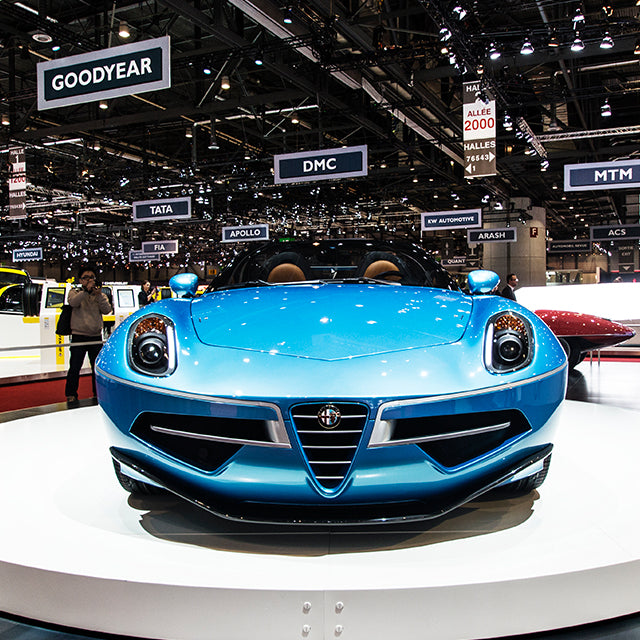Photography by Federico Bajetti
Panelbeating is a craft that forms sheet of metal to a precise shape for (mainly) automotive purposes. In other words, the art of giving a car its visual identity—and stir up car enthusiasts' emotions.
What is truly amazing about classic cars is that they often reflect the soul and ideas of the people who made them—and reconnecting with that is what car passion is all about. Many years have passed since Carrozzeria Touring’s panelbeaters stunned the world with their creations. The nostalgia of those glory days permeates the automotive world today, and there are many enthusiasts who'd still give it all just to have their car dressed by the hands of master craftsmen.
Lately, Carrozzeria Touring Superleggera has been healing many souls by offering limited numbers of stunning cars for a small group of enthusiasts who are often “invited” to acquire these handcrafted bespoke automotive masterpieces. These are cars made for few but to be admired by so many: the unique creations of Touring are the perfect cure for those nostalgic days of handmade elegant automobiles. Their charm will reassure everyone that the art of shaping a car body with the hammer is not lost at all: the language of the carrozzieri is alive and well.

For an “old world” company like Touring, perhaps you’d think the Geneva Motor Show is the least likely place to show off its latest project. In a world of high tech vehicles like the Koenigsegg Regera and the Pininfarina H2, the Alfa Romeo Disco Volante by Carrozzeria Touring Supperleggera is not groundbreaking—it's fascinating.
It feels so refreshing to see that its simple yet sophisticated classic shape is still able to turn heads as much as Pagani's latest creation. If we had to compare this Alfa Romeo 8C-based one off series car with the "typical" Geneva stuff we would come up to labeling it as a pointless style exercise. It is limited to just seven units, based on an old technical design from a “used” car, and maybe the result is not very fast. But who are we to judge? The Disco Volante is remarkable because it embodies the reason why we all love cars, and that reason is hidden in the beautiful lines of its bodywork.
This car comes from another dimension of automotive passion. Like its name suggests, which means "flying saucer", it represents a tangible testament to modern creativity and craftsmanship in the carmaking industry with roots deep into its heritage.
Louis de Fabribeckers, Head of Design for Carrozzeria Touring Superleggera, is the man behind the Disco Volante Spider and the atelier’s other stunning creations. He reinterpreted the language used on the original 1952 Alfa Romeo Disco Volante Spider to create this modern vision; we met him at the Geneva Motor Show 2016 to talk us through it:

Jacopo Villa: Tell me about the design idea behind this beautiful new Alfa Romeo
Louis de Fabribeckers: When Touring proposed to our customers to make an open roof version of the Disco Volante, I immediately started thinking it’s a car with a completely new identity. I did not want to make the Spider version of the Disco Volante Coupé, I wanted to design a new car which could still link back to the original concept we made three years ago. Looking at the original Spider from 1952, I noticed how it was designed to be beautiful without a roof: I wanted to re-create the same feeling and give the spider the same strong identity of the Coupé.
JV: So, the Spider is a completely new car concept from the Coupé?
LF: Yes, we began using the basis of the 8C Spider. I wanted to design a car that developed itself horizontally rather than vertically: in fact, the Coupé is designed with a vertical dynamism, while the Spider is the opposite. We first developed the design by integrating the same fabric roof system as in the original car, but looking at the 8C Spider I realized how the donor car was designed to be "read" without a roof, so I decided to design a new car that would just be like that. I made the upper section of the car look like a visor from a motorcycle helmet: it gives continuity to the lines, and it also helps the car look even more dynamic.

I wanted to have a continuous line of the windscreen and side windows: not only have we obtained a distinct Spider, but a completely new Coupé. This car has no compromises: not only it has a new identity but whenever the hardtop is installed it looks like a completely different. It's a typical atelier car and it is bold and very artistic.
JV: Did you use all handmade aluminum bodywork for the Disco Volante?
LF: The roof, the rear and front bonnets are made out of carbon fiber, while the sides are all hand-beaten aluminum. The carbon fiber windscreen pillars are an integral part of the structure, and are bolted to the chassis with special screws in order to retain the original chassis stiffness and make it suitable for homologation.
JV: Which other modifications did you do to the car?
LF: Nothing was changed except for the exhaust, which was only shortened by a few inches to fit into the bodywork. The new metal chrome ring gives a better resonation to the exhaust note, and it sounds better than the 8C.





















































